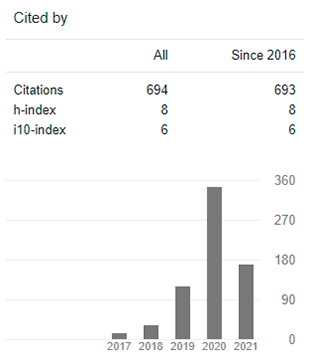Stevia as a sweetener in desserts and its effect on glycemia in patients with diabetes mellitus
Stevia como edulcorante en postres y su efecto sobre la glicemia en pacientes con diabetes mellitus
DOI:
https://doi.org/10.29394/Scientific.issn.2542-2987.2024.9.32.12.250-274Keywords:
organoleptic characteristics, diabetes mellitus, gastronomy, stevia, dessertsAbstract
Diabetes mellitus is a chronic metabolic disease characterized by high blood glucose levels, often leading to dietary restrictions. Therefore, the objective focuses on evaluating the variability of glucose levels before and after the consumption of desserts sweetened with Stevia, in addition to their organoleptic acceptance. This study adopted a mixed and cross-sectional, non-experimental approach. The quantitative part used a glucometer to measure glucose levels, while the qualitative part used a five-point hedonic scale to evaluate organoleptic attributes such as color, aroma, flavor and texture. An analysis of variance (ANOVA), an Anderson-Darling (AD) normality test and a Tukey comparative method of means were performed. Obtaining that the analyzes revealed that there is no significant variation in glucose levels after consuming three different desserts in 55 (21 + 34) participants. Organoleptic acceptability was high, with an average score of 4.6/5. Concluding that the use of Stevia in a proportion of 8% compared to sucrose is viable in manufactured products, without significantly affecting glucose levels in people with diabetes.
Downloads
References
Ahmad, U., Ahmad, R., Arshad, M., Mushtaq, Z., Hussain, S., & Hameed, A. (2108). Antihyperlipidemic efficacy of aqueous extract of Stevia rebaudiana Bertoni in albino rats. Lipids in Health and Disease, 17(175), 1476-511X. Retrieved from: https://doi.org/10.1186/s12944-018-0810-9
Andrade, L., Lee, K., Sylvetsky, A., & Kirkpatrick, S. (2021). Low-calorie sweeteners and human health: a rapid review of systematic reviews. Nutrition Reviews, 79(10), 1145-1164, e-ISSN: 0029-6643. Retrieved from: https://doi.org/10.1093/nutrit/nuaa123
Arrieta, F., Iglesias, P., Pedro-Botet, J., Becerra, A., Ortega, E., Obaya, J., … & Escobar, F. (2018). Diabetes mellitus y riesgo cardiovascular. Actualización de las recomendaciones del Grupo de Trabajo de Diabetes y Riesgo Cardiovascular de la Sociedad Española de Diabetes (SED, 2018). Clínica e Investigación en Arteriosclerosis, 30(3), 137-153, e-ISSN: 0214-9168. Recuperado de: https://doi.org/10.1016/j.arteri.2018.03.002
Cárdenas-Mazón, N., Cevallos-Hermida, C., & Salazar-Yacelga, J. (2021). Elaboración y aceptabilidad de mermeladas utilizando Stevia (Stevia rebaudiana Bertoni) como edulcorante natural brindando una alternativa alimentaria para diabéticos. Polo del Conocimiento, 6(2), 331-340, e-ISSN: 2550-682X. Ecuador: Imprenta y Casa Editora “Coni”.
Carrera-Lanestosa, A., Acevedo-Fernández, J., Segura-Campos, M., Velázquez-Martínez, R., & Moguel-Ordóñez, Y. (2020a,b). Efecto antihipertensivo, antihiperglucemiante y antioxidante de los extractos de Stevia rebaudiana Bertoni (variedad criolla INIFAP C01) en ratas Wistar con síndrome metabólico inducido. Nutrición Hospitalaria, 37(4), 730-741, e-ISSN: 1699-5198. Recuperado de: https://doi.org/10.20960/nh.02858
Cavagnari, B. (2019). Edulcorantes no calóricos: características específicas y evaluación de su seguridad. Archivos argentinos de pediatría, 117(1), e1-e7, e-ISSN: 1668-3501. Recuperado de: https://doi.org/10.5546/aap.2019.e1
Costa, R., Gutiérrez, A., Valdivieso, D., Carpio, L., Cuadrado, F., Núñez, J., & Vásconez, J. (2020). Vigilancia de enfermedades no transmisibles y factores de riesgo. Quito, Ecuador: Ministerio de Salud Pública.
Egan, A., & Dinneen, S. (2019). What is diabetes?. Medicine, 47(1), 1-4, e-ISSN: 1357-3039. Retrieved from: https://doi.org/10.1016/j.mpmed.2018.10.002
El Comercio (2018). La diabetes afecta a un 7,8% de la población en el Ecuador. Ecuador: Grupo El Comercio.
Grayson, B., & Woods, S. (2013). Chapter 151 - Insulin. Handbook of Biologically Active Peptides, 1123-1128, ISBN: 978-0-12-385095-9. Retrieved from: https://doi.org/10.1016/B978-0-12-385095-9.00151-2
Hernández-Ávila, M., Gutiérrez, J., & Reynoso-Noverón, N. (2013). Diabetes mellitus en México. El estado de la epidemia. Salud Publica Mex, 55(suplemento 2), S129-s136, e-ISSN: 1606-7916. Recuperado de: https://doi.org/10.21149/spm.v55s2.5108
Jan, S., Habib, N., Shinwari, Z., Ali, M., & Ali, N. (2021a,b). The anti-diabetic activities of natural sweetener plant Stevia: an updated review. In SN Applied Sciences, 3(517), 1-6, e-ISSN: 2523-3971. Retrieved from: https://doi.org/10.1007/s42452-021-04519-2
OMS (2016a,b). Informe Mundial sobre la Diabetes. ISBN: 978-92-4-356525-5. Ginebra, Suiza: Organización Mundial de la Salud.
OPS/OMS (2023a,b). Diabetes. Washington, D.C., Estados Unidos: Oficina Regional para las Américas de la Organización Mundial de la Salud.
Padilla, M., Martínez, A., Ezzahra, F., Reyes, Z., & Saenz-Pardo, E. (2020). La ingesta de stevia modifica la dinámica del peso corporal, la glucosa y el colesterol en ratas hembras: Algoritmo k-NNs. Archivos Latinoamericanos de Nutrición, 70(2), 144-151, e-ISSN: 0004-0622. Venezuela: Sociedad Latinoamericana de Nutrición.
Peteliuk, V., Rybchuk, L., Bayliak, M., Storey, K., & Lushchak, O. (2021). Natural sweetener Stevia rebaudiana: Functionalities, health benefits and potential risks. Excli Journal, 20, 1412-1430, e-ISSN: 1611-2156. Retrieved from: https://doi.org/10.17179/excli2021-4211
Sambra, V., Castillo, S., & Duarte, L. (2024). Efectos de los edulcorantes no nutritivos sucralosa y estevia en personas con diabetes tipo 1 y 2. Revista Chilena de Endocrinología y Diabetes, 17(1), 16-22, e-ISSN: 0719-5400. Chile: Sociedad Chilena de Endocrinología y Diabetes.
Tang, Y., Long, J., & Liu, J. (2014). Chapter 8 - Hyperglycemia-Associated Oxidative Stress Induces Autophagy: Involvement of the ROS-ERK/JNK-p53 Pathway. Autophagy: Cancer, Other Pathologies, Inflammation, Immunity, Infection, and Aging, 1, 105-115, ISBN: 978-0-12-405530-8. Retrieved from: https://doi.org/10.1016/B978-0-12-405530-8.00008-X
The Look AHEAD Research Group (2014). Eight‐year weight losses with an intensive lifestyle intervention: The look AHEAD study. Obesity, 22(1), 5-13, e-ISSN: 1930-739X. Retrieved from: https://doi.org/10.1002/oby.20662
Zenteno, M., Carreón, T., Martínez, C., García, B., & García, G. (2018). Proceso de vivir con diabetes tipo 2 de la persona y familia: una Teoría Fundamentada. Revista CuidArte, 7(14), 6-17, e-ISSN: 2395-8979. Recuperado de: https://doi.org/10.22201/fesi.23958979e.2018.7.14.69139
Published
How to Cite
Issue
Section
License
Copyright (c) 2024 INDTEC, C.A.

This work is licensed under a Creative Commons Attribution-NonCommercial-ShareAlike 4.0 International License.
The content of the journals of this site, are under a Creative Commons Attribution-Noncommercial-Share Alike 4.0 International License.













